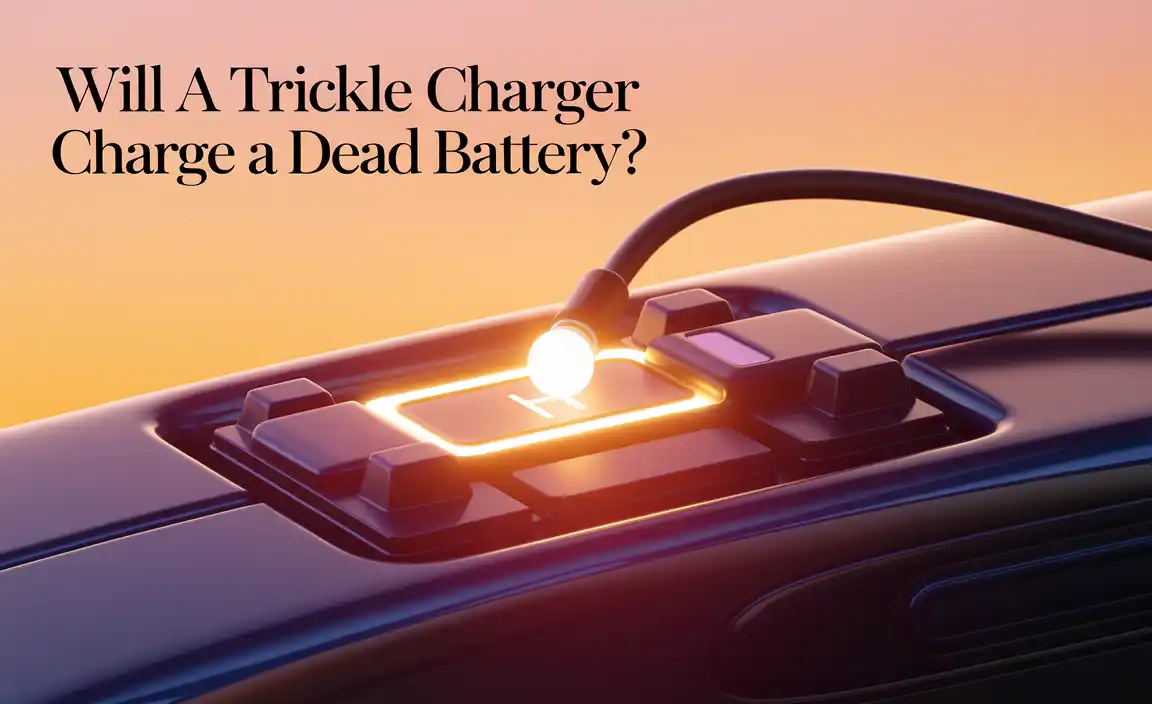Quick Summary:
Finding the right battery for your 2018 Kia Sportage is key to reliable starting. Look for a Group Size 94R (or H7 in some systems) with at least 700 Cold Cranking Amps (CCA). This guide will help you choose, locate, and even replace your battery safely and easily!
Hey there, fellow drivers! Roy Walker here, your go-to guy for all things power. Is your 2018 Kia Sportage giving you a bit of trouble starting up? Does the thought of dealing with a car battery feel a bit daunting? You’re not alone! A dead or weak battery is a super common frustration, turning a quick trip into a major headache. But don’t worry, I’m here to make this simple. We’ll break down exactly what you need to know about the battery for your 2018 Kia Sportage, from picking the right one to understanding its needs. Get ready to feel confident and in control of your car’s power!
Understanding Your 2018 Kia Sportage Battery
Your car battery is like its heart. It provides the jolt of electricity needed to start the engine every single time you turn the key. Without a healthy battery, nothing else in your car – from the radio to the headlights – can even get going. For your 2018 Kia Sportage, it’s important to know that not all batteries are created equal. They come in different sizes, power ratings, and types, and using the wrong one can lead to performance issues or even damage.
One of the most critical specifications is the battery’s group size. This tells you the physical dimensions of the battery and how it should fit into your Sportage’s battery tray. Another key factor is the Cold Cranking Amps (CCA), which measures the battery’s ability to start your engine in very cold weather. Higher CCA is generally better, especially if you live in a colder climate.
Common Battery Problems and Signs Your Sportage Needs a New One
Batteries don’t last forever. They have a lifespan, typically between 3 to 5 years, after which their performance starts to decline. Recognizing the signs of a failing battery can save you from being stranded. Keep an eye out for:
- Slow Engine Crank: When you turn the key, if the engine sounds sluggish and slow to turn over, it’s a classic sign the battery is losing its power.
- Clicking Sound: If you hear a rapid clicking noise when you try to start your car but the engine doesn’t engage, it often means the battery doesn’t have enough power to turn the starter motor.
- Warning Lights: Your dashboard might illuminate with a battery warning light. This could indicate a charging system issue or a battery that’s about to give up the ghost.
- Dim Lights: Headlights, interior lights, or dashboard lights appearing dimmer than usual, especially when the engine is off, can signal a weak battery.
- Electrical Issues: Unexplained problems with your car’s electronics, like the infotainment system or power windows acting strangely, can sometimes be linked to a failing battery.
- Corrosion on Terminals: White or blueish powdery build-up on the battery terminals is corrosion. While this can sometimes be cleaned, it’s often a sign of the battery working harder or leaking, indicating potential issues.
If you notice any of these signs, it’s time to investigate your battery. Ignoring them could lead to your Sportage refusing to start when you need it most.
Choosing the Right Battery for Your 2018 Kia Sportage
When it comes to selecting a new battery for your 2018 Kia Sportage, precision is key. You want a battery that’s specifically designed to meet your vehicle’s power demands. This ensures optimal performance and longevity.
Recommended Battery Specifications
For most 2018 Kia Sportage models, the recommended battery falls into a specific category. While it’s always best to double-check your owner’s manual or use an online battery finder tool, here are the common specifications:
- Group Size: The primary group size you’ll be looking for is 94R. Sometimes, depending on the manufacturer or specific vehicle trim, you might see this referred to as H7. It’s crucial to get the correct dimensions so the battery fits securely in its tray and the terminals align properly with your car’s cables.
- Cold Cranking Amps (CCA): This measures the battery’s ability to start your engine in cold temperatures. For the 2018 Kia Sportage, a minimum of 700 CCA is a good target. If you live in an area with very cold winters, opting for a battery with slightly higher CCA (e.g., 750-800 CCA) can provide extra peace of mind and ensure reliable starting.
- Reserve Capacity (RC): This indicates how long the battery can power your vehicle if the alternator fails. While not as critical as CCA for starting, a higher RC (typically 130-150 minutes or more) is beneficial for powering electronics when the engine is off or during extended idling.
- Terminal Type: Your Sportage will use standard top-post terminals. Ensure the replacement battery matches this configuration.
Pro Tip: Don’t just grab the cheapest battery. Investing in a reputable brand known for quality and durability will often save you money and trouble in the long run.
Battery Types: What’s the Difference?
Batteries aren’t all made the same. The two main types you’ll encounter for automotive use are:
- Flooded Lead-Acid Batteries (Wet Cell): These are the most common and generally the most affordable. They require maintenance, like checking and topping up the water levels (though many are “maintenance-free”). They work well for standard vehicles.
- Absorbent Glass Mat (AGM) Batteries: These are a premium option. The electrolyte is absorbed into mats between the plates, making them spill-proof and much more resistant to vibration. AGM batteries often offer higher CCA, longer lifespan, and better performance, especially in vehicles with heavy electrical loads or start-stop technology. If your 2018 Sportage came with an AGM battery, it’s generally recommended to replace it with another AGM battery for optimal performance, though a flooded battery might work in some cases but may not perform as well.
For most standard 2018 Kia Sportage models that didn’t come factory-equipped with AGM, a high-quality flooded lead-acid battery is usually sufficient and more budget-friendly. However, if you’re looking for enhanced durability and performance, an AGM battery in the correct size (94R/H7) is an excellent upgrade.
When comparing options, consider brands like Optima, Odyssey (often AGM), Bosch, ACDelco, Duralast, and DieHard, which are well-regarded in the automotive battery market.
Where to Buy Your Battery
You have several convenient options for purchasing a battery for your 2018 Kia Sportage:
- Auto Parts Stores: Places like AutoZone, Advance Auto Parts, O’Reilly Auto Parts, and Pep Boys are excellent resources. They usually have knowledgeable staff who can help you find the exact battery you need and often offer free battery testing and installation services. They also typically provide a good selection of brands and price points.
- Dealerships: Your local Kia dealership will have the exact OEM (Original Equipment Manufacturer) battery that came with your Sportage. This is a guaranteed fit and quality, but it’s often the most expensive option.
- Big Box Retailers: Stores like Walmart or Costco often carry a decent selection of car batteries at competitive prices, sometimes under their own store brands or well-known manufacturers.
- Online Retailers: Websites like Amazon or dedicated online auto parts stores sell batteries. Be sure to carefully verify the group size and specifications before ordering, and check their return and warranty policies. Shipping heavy batteries can also be a factor to consider.
External Resource: To understand battery specifications further, the U.S. Department of Energy offers comprehensive information on battery technologies and performance: U.S. Department of Energy – Battery Technologies.
Replacing Your 2018 Kia Sportage Battery: A Step-by-Step Guide
Replacing a car battery is a common DIY task that can save you money. It’s important to follow safety procedures to avoid injury or damaging your car’s electronics.
Important Safety First! Always wear safety glasses and gloves. Car batteries contain corrosive acid. Avoid sparks or open flames near the battery, as they can produce flammable hydrogen gas.
Tools You’ll Need
Gather these tools before you start:
- Safety Glasses
- Work Gloves
- Wrench set or socket wrench with extensions (usually 10mm and 13mm are common for battery terminals and hold-down clamps)
- Wire brush or battery terminal cleaner
- Battery terminal protector spray (optional, but recommended)
- Anti-static mat or old blanket (to protect the ground underneath)
- Memory saver (optional, to retain radio presets and ECU settings)
Step-by-Step Battery Replacement Process
Let’s get your Sportage powered up:
- Locate the Battery: Open the hood of your 2018 Kia Sportage. The battery is typically located on one side of the engine bay, often towards the front. It will be in a plastic tray and secured by a hold-down bracket.
- Turn Off the Engine and Remove the Key: Ensure your car is completely off and the key is out of the ignition.
- Disconnect the NEGATIVE (-) Terminal First: This is the most crucial safety step. Using your wrench, loosen the nut on the clamp for the black cable (negative terminal). Once loose, gently wiggle and lift the cable off the battery post. Tuck it away so it cannot accidentally touch the battery post.
- Disconnect the POSITIVE (+) Terminal: Now, loosen the nut on the clamp for the red cable (positive terminal). Wiggle and lift this cable off the battery post.
- Remove the Hold-Down Bracket: Your battery is secured by a clamp or bracket at its base. Find the bolt(s) holding this bracket in place and remove them. This might require a socket wrench and possibly an extension, depending on the design. Keep these bolts in a safe place!
- Remove the Old Battery: Carefully lift the old battery out of its tray. Batteries are heavy, so use good lifting form. If it’s stuck, check for any hidden brackets or tie-downs.
- Clean the Battery Tray and Terminals: While the battery is out, inspect the battery tray for any damage or corrosion. Use a wire brush or terminal cleaner to thoroughly clean both the cable clamps and the battery posts on your vehicle’s wiring harness. This ensures a good connection.
- Install the New Battery: Carefully place the new battery into the tray. Make sure it’s oriented correctly so the positive and negative terminals align with your car’s cables.
- Secure the Hold-Down Bracket: Reinstall and tighten the hold-down bracket to keep the battery firmly in place. It should be snug but not overly tight.
- Connect the POSITIVE (+) Terminal First: Place the red cable clamp onto the positive post of the new battery. Tighten the nut securely.
- Connect the NEGATIVE (-) Terminal Last: Place the black cable clamp onto the negative post. Tighten the nut securely.
- Apply Terminal Protector (Optional): Spray a thin layer of battery terminal protector onto the posts and clamps to help prevent corrosion.
- Start Your Car: Close the hood and start your Sportage. It should crank up normally. You may need to reset your clock and radio presets if you didn’t use a memory saver.
- Dispose of the Old Battery Properly: Car batteries contain lead and acid and are hazardous waste. Most auto parts stores will accept your old battery for recycling when you purchase a new one. This is often required by law and many places offer a small core charge refund for it.
External Resource: For detailed safety guidelines on handling automotive batteries, the Occupational Safety and Health Administration (OSHA) provides valuable information: OSHA – Powered Industrial Trucks (including battery handling).
Battery Maintenance and Care for Longevity
Even the best battery needs a little attention to last as long as possible. Regular maintenance is simple and can prevent future headaches.
Tips for Extending Battery Life
- Keep Terminals Clean: Regularly check the battery terminals for corrosion (that white or bluish powdery stuff). Clean them with a wire brush and a paste of baking soda and water if you see any. A clean connection is vital for efficient power transfer.
- Ensure Secure Fit: Make sure the battery is firmly held down by its bracket. A loose battery can vibrate and suffer internal damage, as well as cause damage to the tray and cables.
- Avoid Deep Discharges: Try not to drain the battery completely. Leaving lights on, running accessories for extended periods with the engine off, or using a weak battery can shorten its life.
- Protect from Extreme Temperatures: While you can’t control the weather, parking in a garage in extreme heat or cold can help. Extreme temperatures are tough on batteries.
- Test Regularly: If you’re not experiencing issues, it’s still a good idea to have your battery tested by an auto parts store or mechanic annually, especially as it gets older than 3 years. They can check its charge and cranking power.
- Check Water Levels (if applicable): If you have a non-maintenance-free battery, check the electrolyte levels every few months and top up with distilled water only if necessary. Never overfill. Most modern Sportage batteries are sealed and do not require this.
By following these simple steps, you can help ensure your 2018 Kia Sportage battery serves you reliably for years to come.
Battery Specifications Comparison Table
Here’s a quick look at what to expect for your 2018 Kia Sportage battery:
| Specification | Recommended Value(s) | Notes |
|---|---|---|
| Group Size | 94R (or H7) | Ensures proper fit and terminal alignment. |
| Cold Cranking Amps (CCA) | ≥ 700 CCA | Minimum for reliable starting; higher is better in cold climates. |
| Reserve Capacity (RC) | ≥ 130 minutes | Indicates how long the battery can power accessories if the alternator fails. |
| Terminal Type | Top Post | Standard configuration for most vehicles. |
| Battery Type | Flooded Lead-Acid or AGM | AGM offers superior performance but is typically more expensive. |
Remember, the exact specifications can vary slightly based on your specific 2018 Kia Sportage trim and engine. Always verify with your owner’s manual or an online battery finder tool.
Frequently Asked Questions (FAQ)
Q1: How long does a car battery typically last in a 2018 Kia Sportage?
A: A healthy car battery for a 2018 Kia Sportage typically lasts between 3 to 5 years. However, this can be affected by driving habits, climate, and maintenance. It’s a good idea to have it tested annually after the third year.
Q2: Can I use a battery with a higher CCA than recommended?
A: Yes, generally speaking, using a battery with a higher Cold Cranking Amps (CCA) than what’s recommended is perfectly fine and often beneficial, especially in colder climates. It simply means the battery has more power to start your engine reliably in low temperatures. Just ensure the group size and physical dimensions are correct.
Q3: What does the yellow cap mean on a battery post?
A: A yellow cap on a battery post is typically a warning indicator for a hazardous material. It often means the battery contains lead and corrosive acids, which are dangerous. Always handle batteries with care and wear protective gear.
Q4: Do I need to disconnect my car’s electronics or use a memory saver when replacing the battery?
A: It’s not strictly mandatory, but using a memory saver is highly recommended. It connects to your car’s OBD-II port and provides a small power source to keep your car’s computer (ECU), radio presets, clock, and other settings from resetting when the battery is disconnected. This saves you the hassle of reprogramming them later.




